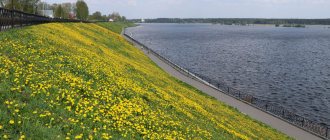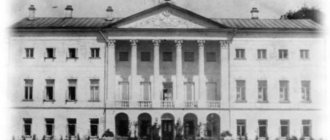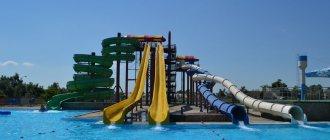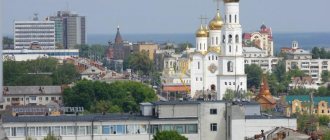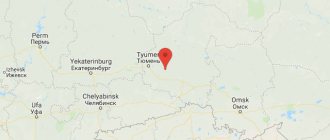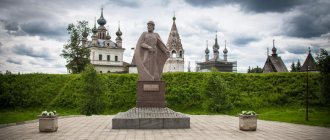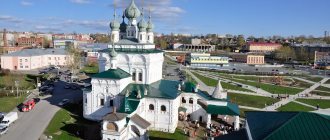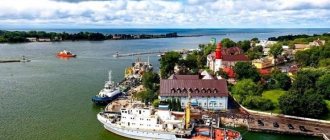The port city of Kronstadt is the most remote suburb of St. Petersburg, which was founded by Peter the Great as a defensive settlement. Its location was ideal for the development of maritime affairs. The first icebreaker in the world was built here, the Baltic Fleet appeared and hydraulic engineering innovations of that time were installed. The place played a significant role in the development of the country, so tourists should come here for new experiences.
City `s history
1703 - Peter I founded the first fort on the Gulf of Finland. Then the fortress was built in 1704, from this date the construction of a new settlement began. The country's naval base was founded here, to which a hospital, medical school, ports, engineering institutions, etc. were added.
@kronshtadt_official
At the beginning of the 20th century, a series of uprisings followed and many local people were killed. During the Second World War, the city's architecture suffered heavy bombing. Factories, landmarks and ordinary houses were destroyed. Restoration work is still underway. Until 1996, the city was closed to visitors. Then it was opened, and it began to attract hundreds of thousands of tourists who want to get to know the Peter the Great era better.
Sights of Kronstadt
One of the iconic landmarks of Kronstadt is the Naval St. Nicholas Cathedral . The temple is active and located in the city center. The architectural style of the cathedral is neo-Byzantine. The building is also decorated with two bell towers and a portal, made in the Gothic and Romanesque styles. Inside the walls of the temple are painted, there are mosaics and frescoes. The collection is surrounded by parkland and walking squares.
Another architectural “pearl” of the historical part of Kronstadt can be considered the Italian Palace . The building was built at the beginning of the 18th century and is considered one of the oldest in the city. The architectural style of the palace is classicism. Currently, the Naval Engineering Institute is located within the walls of the palace.
Gostiny Dvor is another significant landmark of Kronstadt. The Gostiny Dvor building is a monument of history and architecture of the 19th century. Architectural style – classicism. The building is located in the center of Kronstadt and is under state protection.
Ninara/Panorama of Kronstadt
In addition to the Naval St. Nicholas Cathedral, the city is also home to another active Orthodox cathedral - the Church of the Vladimir Icon of the Mother of God . Its construction took place in the first half of the 18th century, the style is a mixture of neo-Russian and neo-Byzantine. The height of the cathedral's bell tower is 50 m. The inside of the temple is decorated with paintings.
The Museum and Historical Park “Island of Forts” opened quite recently. The theme of the park is the history of the navy. At the moment it consists of the Alley of Heroes of the Russian Navy, the Lighthouse of Memory, Panoramic Swings, Sports Tent Camp, Memory Garden, Rope Park, children's playgrounds, an apple orchard with a pond and some other objects. In the future, it is planned to reconstruct the main forts of Kronstadt. The park is located at Citadelskoye Highway, 14. There are parking spaces near the park for those arriving by car.
Ninara/Naval St. Nicholas Cathedral inside
What to see
The sights of Kronstadt are historical buildings associated with the navy and military affairs. The island is surrounded by forts, but you can’t just swim to them, only during an excursion, and even then not all of them. There are also many unusual buildings that will introduce you to the history of St. Petersburg and the Baltic Fleet.
@kronshtadt_official
St. Nicholas Naval Cathedral
Built in the last years before the collapse of the Russian Empire in memory of the fallen sailors. It stands in the central part of the city, towering above other buildings. It has unusual architecture for this area in the neo-Byzantine style. Be sure to go inside to see the rich decoration and intricate paintings on the walls and ceiling. Address: Anchor Square, 1. Opening hours: depends on the schedule of services. Entry cost: free.
Anchor Square
A unique place for the country. There is a cast iron pavement with a patterned pattern in the shape of an anchor. It has an unusual triangular shape, which stretches from the Sovetsky Bridge to the Obvodny Canal. Most of the attractions are located around it. For example, Doc Petrovsky is the oldest hydraulic structure in Russia, and the above-mentioned St. Nicholas Naval Cathedral. Location: city center on the Obvodny Canal. Available every day at any time and completely free.
@kronshtadt_official
Makarovsky Bridge and monument
Admiral Stepan Makarov is an outstanding shipbuilder and explorer. In honor of him, on the opening day of the Naval Cathedral, a monument and a “Red” bridge were erected. The object is interesting for its design. The openwork metal design is made using naval technology. It was created in order to connect two central streets - Anchor Square and Red Square. Location: Anchor Square near Petrovsky Ravine. Available every day at any time and completely free.
Fort "Emperor Alexander I"
It has a second name – “Plague”. This is because there was a laboratory here where research was carried out to combat the plague and other global diseases of those times. Initially, in 1845, it was built to protect St. Petersburg from enemies from the sea. For these purposes, several forts were then built, this one being the best preserved. Location: south of Kotlin Island. Can only be reached by water as part of a tour group.
@kronshtadt_official
Italian palace and pond
The building in the classical style was built in 1717 for the first governor - Alexander Menshikov. This is one of the oldest buildings in the area. It was not possible to preserve the original appearance, as it was rebuilt several times, and in 1926 there was a severe fire. Now the engineering institute is located here. Nearby there is a garden and a pond with a canal. Trade ships passed through it. There is also a monument to the navigator P.K. Pakhstusov and the Admiralty anchor. Address: Makarovskaya street, 3. Can only be viewed from the outside.
Walking through the streets, you will see other interesting locations. For example, the footstaff at the blue bridge, the Cathedral of the Vladimir Icon, the ancient building of the Gostiny Dvor, the main fortress, the lighthouse and more. Allow 1-2 days to become more familiar with the history and explore the area.
@kronshtadt_official
Transport
Directly in Kronstadt, public transport most likely will not be needed - the city is small and its historical center is easy to explore on foot. But if you wish, you can also use buses; there are 3 routes running around the island-fortress, all departing from the Leningradskaya pier. No. 1 ends at the Makarov Gate, No. 2 at Fort Shantz, No. 3 at the Citadel Highway. The fare is about 40 RUB.
Tourists with their own cars don’t have to worry about parking - you can park your car somewhere in the center without difficulty and for free.
It is not recommended to explore the forts of Kronstadt on your own, even in winter; it is better to take a tour right in the city. The cost is low - on foot from 600 RUB per hour per person, boat trips to Fort Emperor Alexander I - from 1000 RUB, depending on the size of the group.
How to get to Kronstadt
The distance from St. Petersburg to Krondstadt in a straight line is only 30 km. Taking into account the roads, the mileage will increase, and the travel time will take about 50 minutes. To travel by car, use GPS coordinates: 59.996322, 29.766704. Head towards the Gulf of Finland on the A-118 highway, which features a long bridge to Kotlin Island. Then turn onto the Kronstadt Highway. You can also order a taxi to the city.
It will be convenient to get there by public transport, which runs regularly. Bus No. 101 from the Staraya Derevnya metro station or minibus No. 510. From Prospekt Prosveshcheniya, minibus No. 407, from Chernaya Rechka No. 405.
From April 25 to November 10, you can sail on the Meteor boat. From the metro station "Ploshchad Lenina", "Arsenalnaya Embankment", pier No. 1 - route No. 7. From "Vasileostrovskaya", pier "Tuchkov Most", pier No. 2.
Opening hours of Kronstadt attractions
- The Naval St. Nicholas Cathedral is a functioning temple, admission to it is free from 10.00 to 19.00 daily.
- The Museum and Historical Park "Island of Forts" also has free admission and is open daily from 08.00 to 21.00.
- The Kronstadt History Museum is open daily from 11.00 to 18.00, except Wednesdays.
- The Kronstadt Maritime Museum is open daily from 11.00 to 18.00, weekends are Monday and Tuesday.
Sergei Gussev/Kronstadt
FAQ
What is Kronstadt famous for?
Kronstadt was built as a port for the development of maritime trade and a fortress to protect the Northern capital. During the Great Patriotic War, Kronstadt was used for the defense of Leningrad; long-range artillery and ships of the Baltic Fleet were located here.
Where is Kronstadt?
The port city is located in the Gulf of Finland on the island of Kotlin, just 30 km away. from St. Petersburg.
How to get there by water?
You need to take the metro to the Lenina Square or Arsenalnaya Embankment station, find pier No. 1 and take route No. 7.
Where to eat in Kronstadt?
Relatively inexpensive establishments are: Cafe-bakery Brioche, VLAVASHE, Strelets. If you want to visit a more colorful establishment, then you should consider the restaurants Dutch Cuisine, Old Kotlin, Kashtan.
Cafes and restaurants in Kronstadt
In Kronstadt there are about 30-35 cafes and restaurants where you can have a snack or a full lunch. The average bill, however, is almost the same: for dinner you can pay from 700 to 1500 RUB per person, just to refresh yourself during a walk - for 300-500 RUB. Of interest is the Soulful Company cafe, where, as they say, they prepare only natural products and only vegetarian food (cream soups, salads, freshly squeezed juices). As well as the restaurants “Admiral” or “Golden Pier” imbued with the maritime spirit.
History of the construction of the Naval St. Nicholas Cathedral
Kronstadt is a maritime city. Once upon a time there was a small maritime church of the Epiphany. However, it could not accommodate everyone, and therefore the idea of building a new, large cathedral was repeatedly expressed.
In 1896, Vice Admiral Nikolai Ivanovich Kaznakov (1834-1906, from 1901 - admiral), who at that time held the position of chief commander of the Kronstadt port, submitted a petition for the construction of a new cathedral in Kronstadt:
... which in its grandeur would correspond to the significance of Kronstadt as the cradle of the Russian fleet and would be a worthy monument both to the ranks of the Naval Department who died in the line of duty, and to outstanding figures who contributed to the development and glory of the fleet. — Quote. by: V.Ya.Krestyaninov. Kronstadt. Fortress, city, port. St. Petersburg, 2014. P.61
In 1897, the collection of donations for the construction of the Naval Cathedral began. The main amount was collected by sailors, who, until 1913, contributed a quarter of a percent of their salaries to the Naval Cathedral. In 1900, a committee for the construction of the cathedral was established, which was headed by the chief commander of the Kronstadt port, Vice Admiral Stepan Osipovich Makarov (1848-1904).
Initially, Nicholas II approved the project of the architect A.I. Tomishko, which, however, was criticized by the committee for the construction of the cathedral. Then the development of the project was entrusted to the famous architect Vasily Antonovich Kosyakov (1862-1921), the author of a number of civil and religious buildings, including for the military department: the Church of the Merciful Mother of God in Galernaya Harbor (St. Petersburg), the Church of the Epiphany in the port on Gutuevsky Island (St. Petersburg), the Church of St. Nicholas the Wonderworker in the Naval Hospital (Kronstadt), the Naval Cathedral in the port of Emperor Alexander III (Libava, now Liepaja, Latvia) and others.
The new temple was supposed to become not just a naval cathedral, but, above all, a monument to all the sailors who died in the performance of their duty. Thus, the “Brief Note on the Construction of the Cathedral” said:
Both when drawing up, and during the development and implementation of the project of the Naval Cathedral in Kronstadt, the main idea of the Committee for the construction of the cathedral was not only to satisfy the religious needs of the Kronstadt sailors, but also to create a cathedral-monument in which the names of the sailors who died since 1696 would be collected g. in the performance of their duty, ship icons and other relics of the fleet. — Quote. by: V.Ya.Krestyaninov. Kronstadt. Fortress, city, port. St. Petersburg, 2014. P.62
On October 27, 1901, clearing of the site for construction began - on Anchor Square , where old anchors were previously stored. On September 1 (14), 1902, after a solemn prayer service performed by John of Kronstadt and in the presence of Vice Admiral S.O. Makarov, construction began. On May 8 (21), 1903, the ceremonial laying of the walls took place, which was attended by Emperor Nicholas II and members of the imperial family.
On June 10 (23), 1913, the Naval Cathedral was consecrated in the name of St. Nicholas the Wonderworker, patron saint of sailors and all travelers. The consecration ceremony of the cathedral was conducted by the protopresbyter of the military and naval clergy, Father Georgy Shavelsky, co-served by the rector of the St. Petersburg Admiralty Cathedral, mitered archpriest Alexy Stavrovsky, and the Kronstadt clergy.
The culmination of the development of the idea of a military temple-monument was the Kronstadt Naval Cathedral - the main temple of the entire Russian fleet. In its design, structure, and the traditions that formed within it, the Naval Cathedral was the result of a long process of development of the temple-monument complex, which became a kind of symbolic mass grave of sailors buried in the depths of the sea, and included a temple - a place of prayerful commemoration of fallen heroes, a repository relics, and a monument to military glory. As a result of development, the Naval Cathedral has absorbed all the best that has been developed over many decades of the existence of military churches. — Elena Isakova. Kronstadt Naval Cathedral in the Orthodox tradition of patriotic education in the navy
Behind the Naval Cathedral in 1911-1914, garden master E.G. Gilbikh laid out the Cathedral Square.
In 1913, a monument was erected on Anchor Square to the outstanding Russian naval commander, oceanographer, polar explorer, shipbuilder, Vice Admiral Stepan Osipovich Makarov , who died on March 31 (April 13), 1904 near Port Arthur, during the Russo-Japanese War.
Monument to Stepan Osipovich Makarov
Shrines
The Naval Cathedral in Kronstadt contains a number of shrines that believers worship:
- Relics of St. Nicholas the Wonderworker. In May 2013, during the opening of the temple after restoration, benefactors donated a particle of the relics of the saint in whose honor the temple was founded 100 years ago. Nicholas the Wonderworker patronizes not only sailors, merchants and travelers. He is also the protector of all those who are slandered and of children.
- Relics of the holy righteous Theodore Ushakov. The great Russian naval commander, Admiral Fyodor Ushakov was and is for the entire Russian fleet the embodiment of a valiant warrior, a brilliant military leader and a man sanctified by true spirituality. Demanding of himself and indulgent of his subordinates, he was a father figure to everyone who needed his protection and patronage. Ushakov’s genius as a fleet commander is evidenced by the fact that not a single ship under his command was lost in battle, and not a single one of his subordinates was captured. In the personality of the naval commander, service to the Fatherland and God came together. In 2001, Fyodor Ushakov was canonized and became the first naval commander in the history of Christianity to be elevated to sainthood.
Naval Cathedral in Kronstadt. The relics of the righteous Theodore Ushakov. - Relics of the Holy Martyrs Elizabeth and Barbara. Elizaveta Feodorovna, whose relics are kept in the Naval Cathedral, was the wife of Grand Duke Sergei Alexandrovich. After the death of her husband, being very pious, the princess became a monk. She created the Marfo-Mariinsky Convent in Moscow, where she spent years in asceticism. In 1918, Elizaveta Feodorovna was arrested. The sisters of the monastery, Varvara and Ekaterina, remained with her. The women were sent to Alapaevsk. Sister Catherine was released, but Sister Varvara refused to part with the abbess of the monastery. Soon both suffered martyrdom: they were thrown into a mine well.
- Relics of St. Sergius of Radonezh. Since the 15th century, Sergius of Radonezh has been revered as a saint, canonized. He is the founder of a number of monasteries and the founder of eldership. Thanks to him, the monastic community was resumed. It is believed that students are under his special protection.
Architectural features of the cathedral
Just like 100 years ago, the dome of the cathedral is crowned with a restored gilded cross. Located at a height of 70 meters, it is visible to sailors hurrying home from a distance of 30 miles. The silvery sky-blue domes are decorated with anchors and lifebuoys made of gilded bronze. On the heavy entrance doors there are images of outlandish fish.
The use of maritime symbols is not only a tribute to the fact that the temple was built for sailors. Even in the apostolic decrees of the 1st century, there are special instructions regarding the construction of Christian churches: to build them like ships. This idea goes back to the image of Noah's Ark, symbolizing salvation. The gigantic building was constructed using the latest technology of the time.
The original project also delights today's builders who restored the cathedral. The dome structure is movable. The metal trusses on which the wood sheathing is constructed are not static, as the hinged supports were installed on a rigid base. This risky design option became a brilliant solution given the large windage of the dome and the enormous wind load.
The mobility of the upper part of the building made it possible to smoothly escape from strong wind blows. Another interesting engineering solution by Vasily Kosyakov was the intersecting arches of the vault. This made it possible to free up the internal space from unnecessary supports, thereby increasing the internal area of the building.
